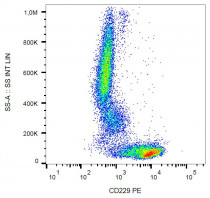ARG53797
anti-CD229 antibody [HLy9.25] (PE)
anti-CD229 antibody [HLy9.25] (PE) for Flow cytometry and Human
Developmental Biology antibody; Immune System antibody
Overview
| Product Description | PE-conjugated Mouse Monoclonal antibody [HLy9.25] recognizes CD229 |
|---|---|
| Tested Reactivity | Hu |
| Tested Application | FACS |
| Specificity | The clone HLy9.25 (also known as HLy9.1.25) recognizes CD229 / Ly9, a 100-120 kDa cell surface glycoprotein expressed on T and B cells. |
| Host | Mouse |
| Clonality | Monoclonal |
| Clone | HLy9.25 |
| Isotype | IgG1 |
| Target Name | CD229 |
| Immunogen | CD299-transfected 300.19 pre-B cell line |
| Conjugation | PE |
| Alternate Names | Signaling lymphocytic activation molecule 3; T-lymphocyte surface antigen Ly-9; Cell surface molecule Ly-9; hly9; Lymphocyte antigen 9; mLY9; CD229; SLAMF3; CD antigen CD229; SLAM family member 3 |
Application Instructions
| Application Suggestion |
|
||||
|---|---|---|---|---|---|
| Application Note | * The dilutions indicate recommended starting dilutions and the optimal dilutions or concentrations should be determined by the scientist. |
Properties
| Form | Liquid |
|---|---|
| Purification Note | The purified antibody is conjugated with R-Phycoerythrin (PE) under optimum conditions. The conjugate is purified by size-exclusion chromatography and adjusted for direct use. No reconstitution is necessary. |
| Buffer | PBS, 15 mM Sodium azide and 0.2% (w/v) high-grade protease free BSA |
| Preservative | 15 mM Sodium azide |
| Stabilizer | 0.2% (w/v) high-grade protease free BSA |
| Storage Instruction | Aliquot and store in the dark at 2-8°C. Keep protected from prolonged exposure to light. Avoid repeated freeze/thaw cycles. Suggest spin the vial prior to opening. The antibody solution should be gently mixed before use. |
| Note | For laboratory research only, not for drug, diagnostic or other use. |
Bioinformation
| Database Links | |
|---|---|
| Gene Symbol | LY9 |
| Gene Full Name | lymphocyte antigen 9 |
| Background | CD229 (Ly9) is a cell surface receptor of the CD150 family, which includes also e.g. CD48 and CD224. Receptors of this family regulate cytokine production and cytotoxicity of lymphocytes and NK cells. High levels of CD229 are found on T and B cells, where its expression increases during their maturation. It is absent on granulocytes, bone marrow-derived dendritic cells, platelets and erythrocytes. CD229 has been also reported on mouse monocytes and NK cells. CD229 interacts homophilically through its N-terminal domain and localizes to the contact site between T cells and antigen presenting B cells during antigen-dependent immune synapse formation. |
| Function | May participate in adhesion reactions between T lymphocytes and accessory cells by homophilic interaction. [UniProt] |
| Research Area | Developmental Biology antibody; Immune System antibody |
| Calculated MW | 72 kDa |
Images (1) Click the Picture to Zoom In








